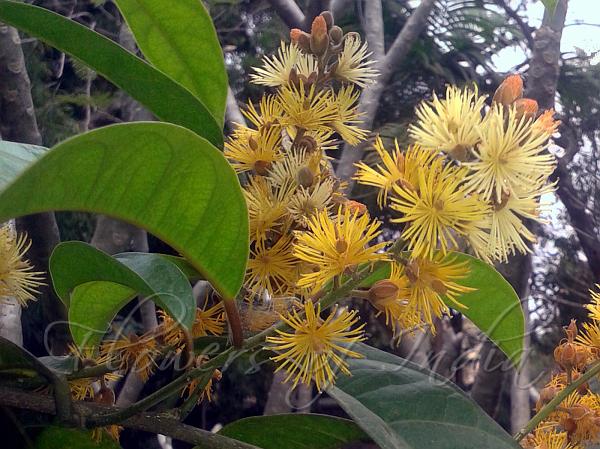|
| Fragrant Caper Vine |
|

|

| File size | 472167 |
| Original date | 3/4/17 2:53 PM |
| Resolution | 1400 x 1050 |
| Flash | Flash fired |
| Focal length | 3.43mm |
| Exposure time | 1/120s |
| Aperture | 2.7 |
| Focus Distance | |
| Metering Mode | Center weighted average |
| Camera make | SAMSUNG |
| Camera model | GT-I8552 |
| Sensor type |
|
|
|
|
Photo: |
Botanical name: Stixis suaveolens Family: Capparaceae (Caper family)
Synonyms: Roydsia suaveolens
Synonyms: Roydsia suaveolens
Fragrant Caper Vine is a climbing shrub, ascending up
to 5 m, finely velvet-hairy, later becoming hairless. Leaves are
oblong, obovate or oblong-lanceshaped, wedge-shaped, somewhat pointed
to rounded at base, abruptly tapering at tip with 5-15 mm long acumen,
14-35 x 4-18 cm, hairless, leathery, glossy and dark green above, pale
green below; lateral nerves 5-12 pairs. Leaf-stalks are 1.5-4 cm long.
Flowers are borne in leaf-axils or at branch-ends, in sturdy panicles,
15-30 cm long, velvety, velvet-hairy; bracts linear or subulate, 2-4 mm
long, finely velvet-hairy. Flowers are fragrant, pale yellow or
greenish-yellow, 1.6-1.8 cm across. Flower-stalks are as long as
bracts, torus about 2.5 mm across. Sepals are elliptic-oblong, 5-6 x
2-2.5 mm, olive green, velvet-hairy, becoming reflexed on maturity.
Stamens are 38-52, filaments 5-6 mm long, hairless; anthers
orange-yellow. Fruit is on a stipe 3-5 mm thick, ellipsoid or obovoid,
2.5-6 x 2-4 cm, orange-brown, scurfy, warty, 3-valved. The fruit is
eaten in China and NE India. Fragrant Caper Vine is found in mixed
tropical and subtropical forests, often along streams, up to 1200 m, in
Sikkim, Assam, Arunachal Pradesh, Nagaland, Manipur, Mizoram, Tripura
and Meghalaya. It is also found in Nepal, Bhutan, Bangladesh, Myanmar,
China and S.E. Asia. Flowering: February-May.
| Identification credit: R.K. Nimai | Photographed in Imphal, Manipur & Mamit area, Mizoram. |
• Is this flower misidentified? If yes,